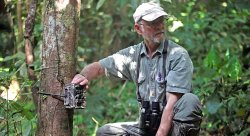PRISM Rainforest Connection and Ocelot Conservation Project Work to Save Big Cats in Panama
Dr. Jackie Giacalone Willis (PRISM) and her husband Greg Willis, place 26+ spy cameras on one of the island’s paths to get shots of wild animals in the depths of a tropical forest.
Posted in: PRISM

In the densely wooded paradise of Barro Colorado Island in the Panamanian tropics, scientists study pumas and jaguars in order to avoid what could be their near future – extinction – and so take a census they deem vital for saving them.
Amid the greenery of Barro Colorado Island, a national monument and natural protected area, the long paths used by felines and other beasts are blurred among the massive trees and leaves carpeting the ground.
As the animals are spotted, data on their behavior in this completely natural environment, never altered by humans, is collected by the scientists.
Professors from New Jersey’s Montclair State University, Dr. Jacalyn “Jackie” Giacalone Willis and her husband Greg Willis, place on one of the island’s paths some 26 spy cameras to get shots of wild animals in the depths of a tropical forest, the likes of which are seldom seen.
These two experts, who since 1982 have taken an annual census in an extension of rain forest covering some 1,500 hectares (3,700 acres), are putting together a photographic record of animals’ behavior, especially that of the ocelot (Leopardus pardalis), which has become the symbol of the study.
While husband Greg set up one of the cameras, zoologist Jackie recounted that it wasn’t until 1994 that they began to use cameras with rolls of film that took 24 photos, a laughable number compared with the digital devices used now, which allow them to take some 8,000 pictures in six months.
“In 2009 we started installing the new cameras equipped with movement sensors, white and infrared flashes, and some with a video option of up to 15 seconds,” Jackie told EFE on a tour around the tropic isle.
A landmark of the study was the photo of a jaguar (Panthera onca) taken that year.
The Smithsonian Tropical Research Institute (STRI), which has managed the area since 1946, published the discovery as proof that the threatened species still survives on Barro Colorado Island.
The documentation helps scientists understand the changes in wildlife in the tropics, where the climate influences biodiversity in one of the world’s unique ecosystems.
Written by News4Europe
Image Gallery
Click on an image below to enlarge photo.

